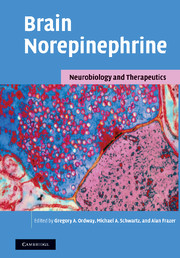Book contents
- Frontmatter
- Contents
- List of contributors
- Acknowledgements
- Introduction: revision of an old transmitter
- Part I The neurobiology of norepinephrine
- 1 Neuroanatomical and chemical organization of the locus coeruleus
- 2 Interactions of norepinephrine with other neurotransmitter systems: anatomical basis and pharmacology
- 3 Receptors for norepinephrine and signal transduction pathways
- 4 Regulation of gene transcription in the central nervous system by norepinephrine
- 5 The norepinephrine transporter and regulation of synaptic transmission
- Part II Norepinephrine and behavior
- Part III The biology of norepinephrine in CNS pathology
- Part IV Psychopharmacology of norepinephrine
- Index
2 - Interactions of norepinephrine with other neurotransmitter systems: anatomical basis and pharmacology
from Part I - The neurobiology of norepinephrine
Published online by Cambridge University Press: 07 September 2009
- Frontmatter
- Contents
- List of contributors
- Acknowledgements
- Introduction: revision of an old transmitter
- Part I The neurobiology of norepinephrine
- 1 Neuroanatomical and chemical organization of the locus coeruleus
- 2 Interactions of norepinephrine with other neurotransmitter systems: anatomical basis and pharmacology
- 3 Receptors for norepinephrine and signal transduction pathways
- 4 Regulation of gene transcription in the central nervous system by norepinephrine
- 5 The norepinephrine transporter and regulation of synaptic transmission
- Part II Norepinephrine and behavior
- Part III The biology of norepinephrine in CNS pathology
- Part IV Psychopharmacology of norepinephrine
- Index
Summary
Introduction
Norepinephrine-containing neurons clustered within the locus coeruleus (LC) provide most of the norepinephrine present within the central nervous system. These cells have tonic pacemaker activity and this activity is regulated by a variety of neurotransmitter inputs. The focus of this review is primarily on classical, non-neuropeptide, neurotransmitter input to the LC and the reciprocal projections of noradrenergic neurons to those classical neurotransmitter systems. Input to the LC from serotonin-, dopamine-, γ-aminobutyric acid (GABA)-, glutamate-, and acetylcholine-containing neurons are described. In addition, input from the neuropeptide, substance P, receives attention because of the interest in this neuropeptide in psychiatric disease. Special attention is given to reciprocal projections from the LC to the monoamine neurotransmitters dopamine and serotonin. See Chapter 1 for a detailed description of the anatomy of the LC.
Noradrenergic circuitry: input to the LC
Early tract-tracing studies suggested that the LC received widespread input from many sites in the brain. A combination of techniques, however, including discrete injections of a more sensitive tract-tracing compound, anterograde labeling studies, and single-pulse stimulation studies forced a reconsideration of brain areas with direct input to the LC. The major afferents to the LC are rostral medullary in origin, with cell bodies located in the nucleus paragigantocellularis (PGi, using excitatory amino acid neurotransmitters) and nucleus prepositus hypoglossi (PrH, using GABA). However, dense projections from many brain regions terminate in the pericoerulear area, an area heavily invested with dendrites from LC neurons, and in the PGi and PrH.
- Type
- Chapter
- Information
- Brain NorepinephrineNeurobiology and Therapeutics, pp. 53 - 67Publisher: Cambridge University PressPrint publication year: 2007
- 1
- Cited by

